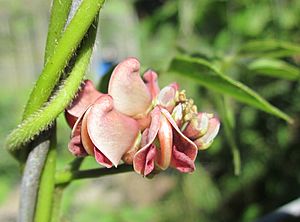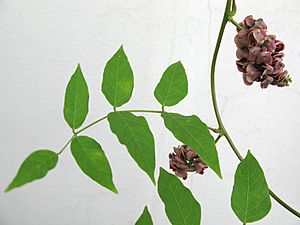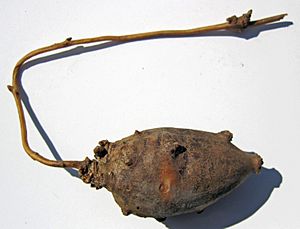American groundnut facts for kids
Quick facts for kids American groundnut |
|
|---|---|
 |
|
| Scientific classification | |
| Kingdom: | |
| (unranked): | |
| (unranked): | |
| (unranked): | |
| Order: | |
| Family: | |
| Genus: |
Apios
|
| Species: |
A. americana
|
| Binomial name | |
| Apios americana Medikus
|
|
| Synonyms | |
|
A. tuberosa Moench Glycine apios |
|

The Apios americana, also known as the potato bean, hopniss, Indian potato, or American groundnut, is a special plant. It's a perennial vine, which means it lives for many years. This vine grows edible beans and large, tasty tubers.
Its vine can grow quite long, from about 3 to 20 feet (1 to 6 meters). The leaves are about 3 to 6 inches (8 to 15 cm) long and have 5 to 7 smaller leaflets. The flowers are usually pink, purple, or reddish-brown. They grow in tight clusters that are about 3 to 5 inches (7.5 to 13 cm) long. The fruit is a pod, like a bean pod, about 2 to 5 inches (5 to 13 cm) long.
The edible parts that grow underground are called tubers. They are like small potatoes. These tubers are actually special stems, not roots. You can find the American groundnut growing naturally from southern Canada all the way down to Florida and west to Colorado. It's also a food source for the caterpillars of the Epargyreus clarus butterfly.
Contents
What's Inside? (Nutrition)
The tubers of the American groundnut taste a bit like potatoes, but they can be nuttier. Their texture is also finer. It's important to always cook these tubers before eating them. Raw tubers contain certain substances that are not good for you, but cooking removes them.
These tubers are packed with good things! They have about three times more protein than a potato. They also have a good balance of important building blocks called amino acids. The tubers are also a great source of calcium and iron. They have 10 times more calcium and 2 times more iron than a potato. However, they have less vitamin C than potatoes.
The tubers also contain a lot of carbohydrates, mostly starch, which gives you energy. Both the tubers and the flowers have special sugars called mono and oligosaccharides. The tuber has more of these sugars than soybeans, potatoes, and sweet potatoes.
Health Benefits
Eating American groundnut tubers may offer several health benefits. Studies have shown that they might help lower blood pressure in some cases. They could also help reduce cholesterol and triglycerides (types of fats in your blood).
The tubers contain special plant compounds called isoflavones, like genistein. These compounds are thought to have health benefits, including possibly helping to protect against certain types of cancer, such as colon, prostate, and breast cancer.
The flowers of the American groundnut are also interesting! Research suggests they are safe to eat. In studies, eating the flowers helped lower blood sugar levels in diabetic mice. This means the flowers could be a new food source that might help prevent diabetes.
Where is it Grown? (Cultivation)
Today, the American groundnut is mostly farmed for sale in Japan. Before it came to Japan, people there already knew about a similar wild plant called hodoimo. They sometimes ate it when other food was scarce.
It's believed that the American groundnut arrived in Japan sometime between 1868 and 1912. One idea is that it came by accident, perhaps mixed in with apple tree seedlings from North America. Another idea is that it was brought to Japan on purpose as a pretty flower.
The American groundnut has become a special food in the Aomori Prefecture in Japan, where most of it is grown. People there have been eating it for over a hundred years. It's also grown in nearby areas like Akita and Miyagi, and even in the southern part of Japan.
A lot of its popularity in Japan is thanks to Dr. Kiyochika Hoshikawa. He worked hard to encourage people to grow this plant. Many scientific articles have also highlighted the health benefits of eating American groundnut tubers. Websites in Japan that sell American groundnut still talk about its health benefits to attract buyers. There are also reports of it being grown in South Korea for its nutritional value.
How is it Used? (Uses)
Both the tubers (the underground parts) and the seeds of the American groundnut can be cooked and eaten.
By Native Americans
For a long time, the tubers were a very important food for many Indigenous peoples of the Americas who lived where the plant grew naturally. In 1749, a traveler named Peter Kalm noted that Indigenous people ate a wild plant called "Hopniss" or "Hapniss." He said the roots looked like potatoes and were boiled and eaten instead of bread.
Early records show that Indigenous peoples in Virginia, Eastern Canada, and other regions ate these tubers. The Cree people even grew the plant for both its tubers and seeds. The Lenape people called the tubers "hobbenis." The Iroquois also ate a lot of groundnuts. Some Iroquois tribes were even known as the "Potatoe tribe."
Indigenous peoples prepared the tubers in many ways. They would fry them in animal fat or dry them into flour. Some tribes, like the Menomini, would peel and dry the tubers in the sun for winter. They even boiled them in maple syrup to make a preserve! The Potawatomi traditionally boiled their tubers. The Meskwaki and Chippewa would peel, partly boil, slice, and then dry the tubers. The Chippewa even used them as a seasoning in their food.
By Europeans
Europeans learned how to use the American groundnut from the Indigenous peoples. This plant played a role in the early history of the American colonies and even in Europe. In 1602, an early traveler named John Brereton survived on the "good meat" of the American groundnut in New England.
The American groundnut was very important for the survival of the Pilgrims during their first few winters in the New World. In 1623, with little corn left, the Pilgrims "were enforced to live on groundnuts... and such other things that the country afforded." The Wampanoag people taught the Pilgrims how to find and prepare the American groundnut. It was likely eaten at the first Thanksgiving harvest festival in November 1621.
The philosopher Henry David Thoreau also wrote about the nutty taste and dry texture of the groundnut in 1852.
The American groundnut may have been sent to Europe as early as 1597. It was even listed as a garden crop in Europe in 1885. During the Great Famine in Ireland in 1845, it was considered a possible alternative to potatoes. However, it didn't become a common food in Europe. One reason was that it took two years for the tubers to grow enough, which didn't fit with how Europeans usually farmed.
Making it a Farm Crop (Domestication)
The American groundnut is generally considered a wild plant, not one that has been fully "domesticated" like corn or wheat. Some historical records suggest that Native Americans "cultivated" it. This might have meant they moved the tubers closer to their homes. However, modern ideas about farming, like permaculture, suggest that Native Americans did actively manage and grow native plants in ways that could be called cultivation.
In 1985, scientists at Louisiana State University in Baton Rouge started a project to try and domesticate the American groundnut. Their main goal was to create a type that could produce a lot of tubers in just one growing season. They looked for plants with larger tubers that grew close together and could be grown without special supports. They collected wild seeds and tubers from many states, especially Louisiana.
This program continued until the mid-1990s. Even today, you might find some of these special types of American groundnut from small seed companies.
From 1985 to 1994, a special breeding program for Apios plants took place. Scientists collected over 200 wild plants and created more than 2,200 new plant lines by mixing different types. They tested these plants in various places and conditions. They found that some plants grew very large, producing up to 3.3 pounds (1.5 kg) of tubers underground. This shows that the plant can grow well in many different places and conditions. The best types found in this project could be used to develop new farm crops.
Today, the largest collection of American groundnut types is at Iowa State University. Scientists there continue to research how to make the American groundnut a better farm crop.
Despite these efforts, the American groundnut is still not widely grown in North America and Europe. There are some challenges. For example, it's hard to get seeds from some plants, and the tubers are often small, usually less than 1.7 ounces (50 grams). Also, the tubers grow like "beads on a string" along long underground stems, which makes them hard to harvest.
Helping the Soil (Nitrogen Fixation)
One great advantage of the American groundnut is that it can create its own nitrogen. Nitrogen is a very important nutrient for plants to grow. Other root crops like potatoes, true yams, and sweet potatoes need a lot of nitrogen fertilizer added to the soil.
The American groundnut can work with special bacteria found in the soil. These bacteria help the plant take nitrogen from the air and turn it into a form the plant can use. This process is called nitrogen fixation.
Studies have shown that American groundnut plants that work with these bacteria grow about 30% better if no nitrogen fertilizer is used. However, if nitrogen fertilizer is added, plants without the bacteria might produce more tubers. This suggests that some nitrogen fertilizer might still be helpful to get the biggest tubers and harvests from A. americana.
Different Types (Ploidy Genetics)
Most American groundnut plants have 22 chromosomes (these are like tiny instruction manuals inside cells). These are called "diploids." But there are also "triploids" which have more chromosomes.
Only diploid plants can produce seeds. Triploid plants will grow flowers but no seeds. This means triploids can only be grown by dividing their tubers, while diploids can be grown from both seeds and tubers. Other than not producing seeds, it's hard to tell the difference between diploids and triploids.
Triploid plants are usually found in the northern parts of the American groundnut's range, like in Canada and some northern U.S. states. Diploids are more common in the southern parts.
See also
 In Spanish: Apios americana para niños
In Spanish: Apios americana para niños


